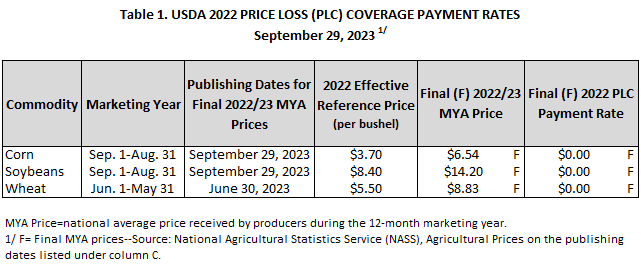Farm Bill Programs offer limited support for 2022 production year
USDA releases 2022 payment data and 2023 projections for PLC/ARC-CO.

As producers await the creation of a 2024 Farm Bill, new data emerges on support provided by current programs. At the end of September, USDA released 2022 payment rates for both Price Loss Coverage (PLC) and Agriculture Risk Coverage (ARC-CO). For Michigan field crop growers, little aid was provided by either program. Projected rates for 2023’s PLC payment rates were also revealed, indicating similar support expected for this year’s production.
The level of support offered is expected to renew calls for program reform. But in order to better adjust programs, it’s important to understand what factors influence payment rates.
Price Loss Coverage (PLC)
PLC payments are based on a market year average price (MYA). A market year begins at harvest and continues until the next harvest. For 2022 corn and soybean production, those months include September 2022 through August 2023, while wheat runs from June 2022-May 2023. To trigger a payment, the market year average price must fall below a statutory reference price. The difference becomes PLC’s payment rate.

As illustrated in Table 1, reference prices were listed at $3.70 for corn, $8.40 for soybeans and $5.50 for wheat. The final MYA for all crops were significantly higher compared to their reference prices. Corn’s MYA price was $6.54, soybeans at $14.20 and wheat at $8.83. This leads to payment rates are $0.00 for all three crops.
Under the current farm bill, there is a provision that can lead to an adjustment in reference prices. This requires the Olympic average of the MYA over a crop’s last five years to be greater than the statutory reference price. In an Olympic average, both the highest and lowest values are removed before calculating an average. For 2022, the years considered included 2017-2021. The highest MYA excluded from the Olympic average calculation was from 2021 when commodity prices began to increase. The resulting average was less than current reference prices and therefore not used in delivering PLC payments.
A similar scenario is projected to play out for 2023’s production year.

Table 2 illustrates that expected reference prices will also remain set at current statutory levels. Even with 2021 prices included, the 85% Olympic Average is not expected to be large enough to adjust reference prices. The projected market year average prices are also expected to be significantly higher than reference prices. Projected payment rates are expected to be $0.00.
PLC would work as intended if market prices were closer to reference prices. However, the last time that occurred was in the 2014 Farm Bill era. Payment triggers occurred more regularly for corn, soybeans, and wheat from 2014-2018. In lieu of waiting for lower prices, many calls for reform focus on changing reference prices, either by raising reference prices directly or altering the criteria of how they can adjust. What these types of changes could look like have been the topic of several articles written by Michigan State University Extension and Illinois Farmdoc.
Agriculture Risk Coverage – County (ARC-CO)
Agriculture Risk Coverage has not faced as many calls for reform as PLC. The reason for that is likely because payments are based on county revenues. County revenues are calculated using a crop year’s market year average price multiplied by the county average yield. The emphasis on both price and yield is a key difference between ARC-CO and PLC. Offering more than one factor that can lead to support payments.

For payments to trigger, the actual county revenue must be less than the coverage guarantee. The coverage guarantee is 86% of the benchmark revenue, which is a five-year Olympic average of previous county revenues. The continual focus on revenue is an important component of determining support. In years where prices may be higher, yield losses can still trigger payments. As Table 3 illustrates, five Michigan counties saw payment triggers in 2022 largely attributed to yield losses.
Delta was the only county to see a payment trigger in corn. The coverage guarantee of $360.30 was established on a 113.23 bushel average and a $3.70 per bushel price. The 2022 actual county revenue of $279.45 was less, despite using a MYA price of $6.54. The actual county yield of 42.73 bushels was a significant loss and led to a payment rate of $41.90. The same situation occurred with soybeans in Chippewa, Delta, Luce, and Mackinac. No Michigan counties saw ARC-CO payments for wheat acres in 2022.
Projections for 2023 payments have not been released, but benchmark data is available. Benchmark prices will rise with corn at $3.98 and soybeans at $9.57. Wheat prices will remain the same at $5.50. With drought and excessive rainfall affecting several counties this season, it is possible that yields will be a factor in ARC-CO payments. Prices may also play a factor with lower projected MYA prices for 2023.
For the latest on PLC and ARC-CO program information, visit USDA’s ARC/PLC Program Data website. MSU Extension will also be hosting several Farm Bill webinars as part of the new Farm Policy & Risk Management Series. The series is free of charge, but registration is required.



 Print
Print Email
Email




